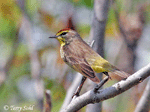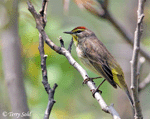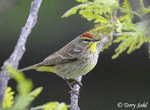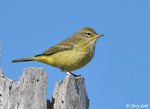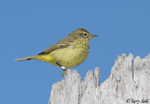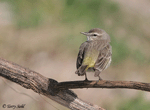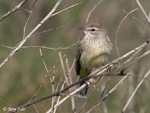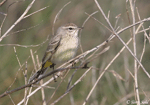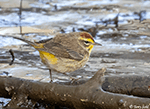| Length: 5.25 inches | Wingspan: 8.5 inches | Seasonality: Migrant |
| ID Keys: Variable, with a less common "Yellow Palm Warbler" in the extreme east, and a more drably colored plumage. All have a chestnut cap, pale eye-brow, yellow undertail coverts, and a habit of bobbing their tail as they forage.. | ||
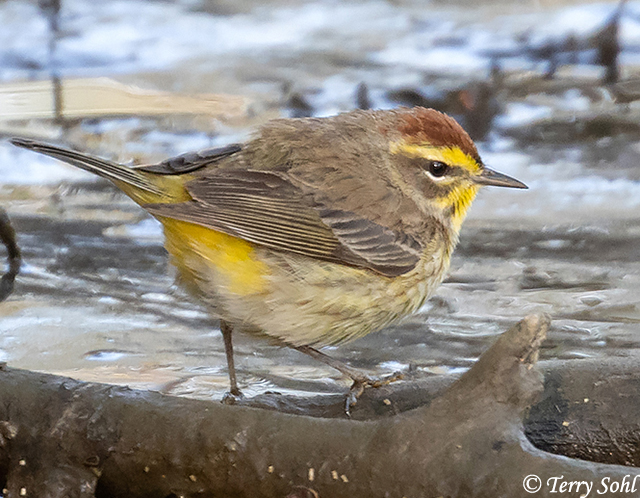 Palm
Warblers are a fairly common sight during spring migration in the eastern U.S.,
as they are most often in low vegetation and are readily identifiable because of
their tail-bobbing habit. Despite the name, Palm Warblers generally don't
forage or roost in palm trees, even during their winter months in Florida or the
tropics. The "Yellow Palm Warbler" is a more colorful version found in smaller
numbers in the extreme eastern portions of North America, with more extensive
yellow on the underparts than the birds that typically migrate through South
Dakota.
Palm
Warblers are a fairly common sight during spring migration in the eastern U.S.,
as they are most often in low vegetation and are readily identifiable because of
their tail-bobbing habit. Despite the name, Palm Warblers generally don't
forage or roost in palm trees, even during their winter months in Florida or the
tropics. The "Yellow Palm Warbler" is a more colorful version found in smaller
numbers in the extreme eastern portions of North America, with more extensive
yellow on the underparts than the birds that typically migrate through South
Dakota.
Habitat:
Found in sphagnum bogs with scattered trees during the summer breeding season. In winter and in migration, they are generally found in low vegetation, such as brush, hedgerows, short second-growth forest, and overgrown fields.
Diet:
Feeds on insects, spiders, berries, and seeds.
Behavior:
Will sometimes join mixed flocks of warblers, chickadees, sparrows, and juncos during fall and winter. Much of its winter foraging is conducted on the ground, while summer foraging is largely conducted in trees and brush.
Breeding:
Non-breeder in South Dakota. On their breeding grounds, the nest of a Palm Warbler is placed on the ground, typically at the base of some woody vegetation such as a shrub or a small tree. The nest is a cup constructed of mosses, grasses, and other bits of vegetation, lined with finer material such down, hair, or fine grasses. The female lays 3 to 5 eggs, and both parents help to incubate the eggs. Incubation last about 12 days, with young fledging from the nest 10-14 days after hatching.
Song:
Buzzy simple trilling, often with more emphasis in the middle. Palm Warblers also have a quiet tseep call.
1Click here for the song of a Palm Warbler
2Click here for the call of a Palm Warbler
Migration:
Summers throughout central and southeastern Canada, the extreme northern Great Lakes region, and northern New England. Winters near the Atlantic and Gulf Coasts of the southeastern U.S., Mexico, and Central America. A few winter along the Pacific Coast every year.
Interactive eBird Map:
Click to access an interactive eBird map of Palm Warbler sightings
Similar Species:
Most likely to be confused with the following warbler species:
- Cape May Warbler - Cape May Warbler share some of the same coloring as a Palm Warbler, including a rusty color on the head. However, on a Cape May Warbler, that rusty color is found as a patch below the eye (with a dark cap), while Palm Warblers have a rusty cap. Cape May Warblers have a yellow collar that extends to the back of the neck, while yellow on head of a Palm Warbler is restricted to the throat and a stripe above the eye. Cape May Warblers have stronger, more consistent streaking on the breast and flanks than does a Palm Warbler. All of the previous characteristics apply to male birds! Female of the two species are also similar overall, but Cape May Warblers lack the yellow stripe above the eye and the pale brownish crown of a female Palm Warbler.
- Prairie Warbler - Prairie Warblers lack the rusty cap of a Palm Warbler and have a stronger facial pattern, with a strong black line through the eye and another lower on the cheek. Prairie Warblers have strong, black streaks on the breast and flanks, while Palm Warblers have less distinct, brownish streaks.
Conservation Status:
In the summer breeding season, Palm Warblers are found in boggy wetland habitats, a type of habitat that hasn't undergone as dramatic a decline as some other habitat types in North America. In migration and winter, they can utilize a variety of shrubby habitats, including disturbed lands that may result from human activity. As a result, Palm Warbleres haven't been as negatively impacted by human activity as have many bird species. They are found across a very broad geographic area, are common in parts of their range, and surveys in recent decades indicate actual overall population increases. As a result, the IUCN considers the Palm Warbler to be a species of "Least Concern".
Further Information:
2) Audubon Guide - Palm Warbler
Photo Information:
May 9th, 2020 -- Outdoor Campus in Sioux Falls, South Dakota -- Terry Sohl
Additional Photos:
Click on the image chips or text links below for additional, higher-resolution Palm Warbler photos.
Audio File Credits:
1William Whitehead. Recorded in Middlesex County, New Jersey on April 14th, 2018. Original recording and information from xeno-canto.
2Paul Marvin. Recorded in Viera Wetlands of Florida on October 25th, 2013. Original recording and information from xeno-canto.
| Click on the map below for a higher-resolution view |
 |
| South Dakota Status: Uncommon migrant in the eastern part of the state, much rarer in the West. |
Additional Palm Warbler Photos
Click for a higher-resolution version of these photos
